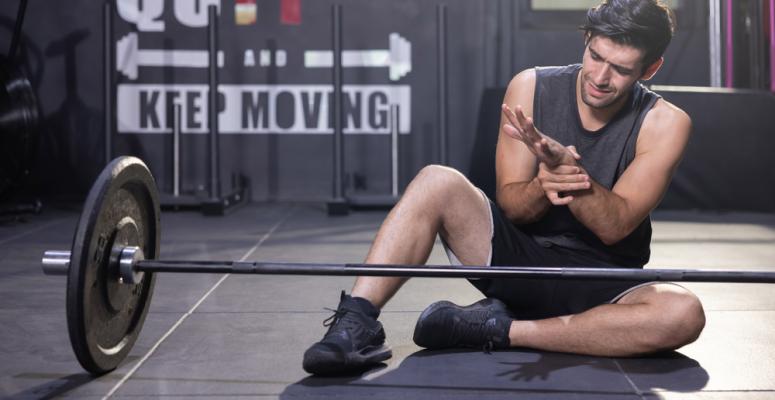
Do you feel a pain in your wrist, especially when you bend it or lift heavy objects? Does it feel warm or tender to the touch?
If so, there's a chance you have wrist bursitis. In this article, we'll discuss what this condition is and what you can do for pain relief.
What is wrist bursitis?
Wrist bursitis occurs when one or more of your wrist bursa sacs become inflamed. The bursa sacs are small, slippery pieces of soft tissue that provide cushion and lubrication for the joints. With inflammation in your bursa sacs, they aren't able to serve their function, so moving or putting pressure on the joint becomes painful.
Your wrist isn't the only place where bursitis can occur. It's also a common cause of knee pain, elbow pain, and other forms of pain (1 in 10,000 people develop knee or elbow bursitis every year). Bursitis can take the form of acute pain (a one-time incident) or chronic pain (recurring).
What causes bursitis in the wrist?
Bursitis can be caused by either traumatic or repetitive stress injuries. In other words, it could occur after a broken wrist or during the healing process. However, it can stem from a repetitive action that places stress or pressure on the upper extremities.
For instance, a truck driver may experience wrist bursitis after months of driving a manual transmission vehicle, or a house painter might experience bursitis due to the stress painting puts on their wrist.
The repetitive nature of these tasks can cause friction in the wrist joints, irritating the bursae. If the joints become irritated enough, the body starts to send increased blood flow to that area, leading to inflammation.
Wrist bursitis can also stem from various types of arthritis, including osteoarthritis and rheumatoid arthritis.
What does wrist bursitis feel like?
Wrist bursitis can produce a range of symptoms, but most cases are accompanied by pain, warmth and tenderness to the touch. It sometimes produces a small but visible (and painful) lump in the wrist. This bump is a visible sign of inflammation, a result of the body sending white blood cells to fight bacteria in the irritated joint.
Wrist bursitis home remedies
If you are experiencing wrist bursitis, it's recommended to speak to a medical professional. They'll diagnose your condition and assign you a treatment plan that can help you manage your symptoms.
However, there are a few things you may be able to do to get rid of bursitis naturally at home:
- Rest ” Avoid using your affected wrist as long as you're still showing symptoms. Rest will help you avoid irritating your bursitis and causing further injury.
- Elevate your arm ” Elevating your wrist helps to drain any excess waste fluid created during the inflammation process. This can help reduce swelling and speed up the healing process.
- Alternate ice and heat ” Ice slows the circulation to your wrist, numbing your pain and reducing swelling. When you apply heat after 20 minutes of ice, your veins expand rapidly, allowing a rush of blood, nutrients and oxygen to rush to your wrist to promote healing.
Again, it's recommended to speak to a doctor or physical therapist in your area. They may be able to recommend more effective treatments than the ones you can perform on your own at home.
How long does it take for wrist bursitis to go away?
Most cases of bursitis subside within a few weeks, but healing times vary depending on the severity of the inflammation and the treatment routes pursued. If a person's bursitis leads to an infection, they may require antibiotics before their wrist begins to heal. People who experience chronic or recurrent bursitis may notice that it takes longer for their swelling to subside.
Is physical therapy good for wrist bursitis?
Physical therapy can be an effective treatment for wrist bursitis (and other forms of bursitis). Here's how it helps:
- Relieves pain ” Physical therapists use manual therapy to physically push any pain-causing tension out of your soft tissue.
- Reduces swelling ” Physical therapists teach you therapeutic exercises that can help reduce swelling in your wrists.
- Improves flexibility ” Joint mobilization and other techniques can reduce any stiffness in your arm that's increasing your pain.
- Strengthens wrists ” Therapeutic exercises can also strengthen your wrists, reducing the pain felt when lifting heavy objects.
- Eliminates bad habits ” Some cases of bursitis stem from bad posture or form when performing repetitive tasks. Your physical therapist will assess your posture and form to identify and correct any bad habits that caused your bursitis.
If your bursitis occurred after a surgery, physical therapy can also help you in your recovery (and to heal any scar tissue on your wrist).
Alliance PTP is ready to help you find top-notch PT for wrist bursitis
At Alliance Physical Therapy Partners, we're proudly bringing together physical therapy practices across the country to help people get the high-quality PT they need. Want to see a physical therapist in person? We can put you in touch with an Alliance PTP partner that's close to you and that can help you address wrist pain.
Not keen on in-person PT sessions or not close to an Alliance PTP partner? No worries. We also offer effective and affordable virtual physical therapy through our Agile Virtual Physical Therapy platform.
Contact our team today so we can help you find the most effective physical therapy services for your injury or condition.
Get Help at a Location Near You
